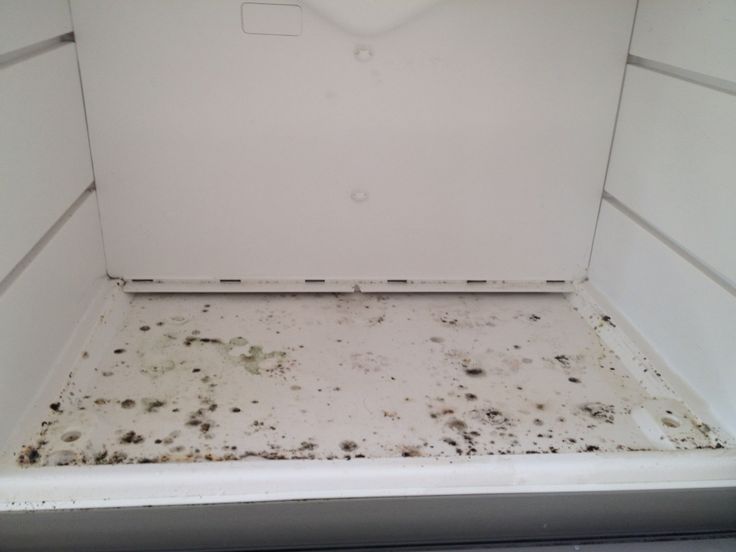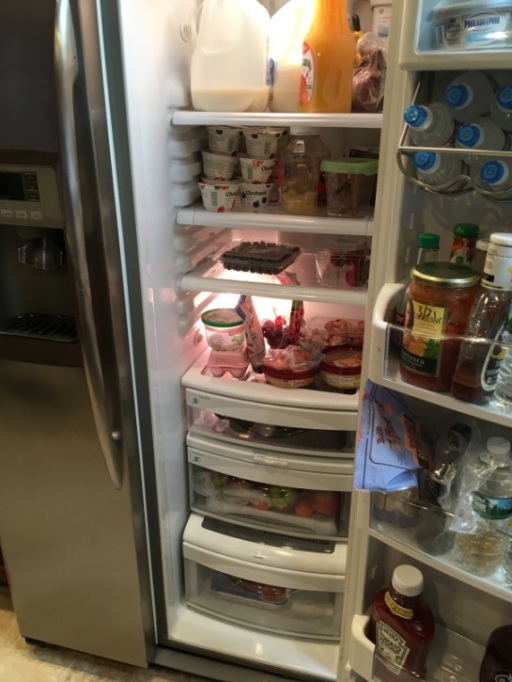Yes, black mold in the freezer is dangerous. The presence of black mold in the freezer can pose health risks and contaminate food.
Black mold contains mycotoxins, which can cause respiratory issues and other health problems. If left untreated, it can spread and worsen over time. Regular cleaning and maintenance of the freezer are essential to prevent the growth of black mold. In this blog, we will explore the dangers of black mold in the freezer and provide tips for preventing and addressing this issue to ensure a safe and healthy environment for food storage.
Introduction To Black Mold In Freezers
Black mold in freezers can be a cause for concern as it poses potential health risks. Black mold, also known as Stachybotrys chartarum, is a type of fungus that thrives in damp and dark environments. It typically appears as black or dark green patches and can release spores into the air, which can be inhaled or come into contact with food stored in the freezer.
The presence of black mold in freezers can be attributed to various factors. Moisture buildup, such as from food spills or leaks, creates an ideal environment for mold growth. Additionally, if the freezer is not regularly cleaned and maintained, mold can develop on leftover food or organic matter.
Exposure to black mold can lead to respiratory issues, allergic reactions, and other health problems, especially for individuals with weakened immune systems or pre-existing respiratory conditions. It is important to address any signs of black mold in freezers promptly to prevent further spread and potential health hazards.
To prevent black mold in freezers, it is crucial to maintain cleanliness and proper ventilation. Regularly clean and dry the freezer, paying attention to spills or leaks. Ensure proper food storage and discard any expired or moldy items. If mold growth persists, it is recommended to seek professional help for thorough cleaning and remediation.

Credit: www.reddit.com
Identifying Black Mold
Black mold can be a health hazard, and it’s important to identify it in your freezer to ensure the safety of your food. When inspecting your freezer, look for visual characteristics that indicate the presence of black mold.
Some common visual characteristics of black mold include a slimy texture, black or dark green color, and a musty odor. Additionally, black mold may appear as spots or patches on the walls, shelves, or food items in your freezer.
Common Locations In Your Freezer
Black mold can thrive in areas with high humidity and moisture. In your freezer, common locations where black mold may be found include the rubber door seals, drain pans, and vents. It can also develop on food items that have been left to spoil.
To prevent the growth of black mold in your freezer, it’s essential to maintain proper temperature and humidity levels. Regularly clean and disinfect your freezer, paying close attention to the areas where mold is more likely to develop.
Health Risks Of Black Mold Exposure
Exposure to black mold in the freezer can lead to various respiratory issues such as coughing, wheezing, and throat irritation. Additionally, individuals may experience allergic reactions including skin rashes, itchy eyes, and nasal congestion. Prolonged exposure to black mold may result in long-term health complications like chronic respiratory infections and fatigue. It is essential to address any mold presence promptly to mitigate these potential health risks.
Preventing Mold Growth In Freezers
Black mold in freezer can be dangerous for both your health and the quality of food stored. Regular cleaning of the freezer is the key to preventing mold growth. Make sure to wipe down any spills or leaks immediately with a solution of vinegar and water. Proper food storage is also important. Use airtight containers for leftovers and ensure that they are cooled to room temperature before placing in the freezer. Always label and date the containers to keep track of the contents. Maintaining optimal temperature and humidity is crucial. Keep the freezer temperature at or below 0°F and humidity levels below 50%. Defrost the freezer regularly to prevent ice buildup and maintain proper airflow. By following these tips, you can prevent the growth of mold in your freezer and ensure the safety of your food.
| Tips | Description |
|---|---|
| Regular cleaning | Wipe down any spills or leaks immediately with a solution of vinegar and water. |
| Proper food storage | Use airtight containers for leftovers and ensure that they are cooled to room temperature before placing in the freezer. Always label and date the containers to keep track of the contents. |
| Maintaining optimal temperature and humidity | Keep the freezer temperature at or below 0°F and humidity levels below 50%. Defrost the freezer regularly to prevent ice buildup and maintain proper airflow. |
Safe Removal Of Black Mold
Black mold in the freezer is a serious matter and should be dealt with immediately. DIY cleaning solutions can be effective in removing the mold, but it is important to take the necessary precautions to ensure your safety. Always wear protective gear such as gloves, goggles, and a mask to prevent inhaling mold spores.
If the mold has spread extensively or the job seems too daunting, it may be best to call in professionals. They have the experience and equipment to safely remove the mold and prevent it from coming back.
| DIY Cleaning Solutions | Professional Removal |
|---|---|
| Vinegar and baking soda | Use of specialized equipment |
| Bleach and water solution | Safe disposal of contaminated materials |
| Hydrogen peroxide | Thorough cleaning and disinfection |
Overall, black mold in the freezer should not be taken lightly. Whether you choose to tackle it yourself or seek professional help, it is important to take the necessary precautions and ensure safe removal.

Credit: www.acecorentals.com.au
Understanding The Impact On Food Safety
Black mold in a freezer can be dangerous to your health as it can contaminate the food stored inside. The mold spores release mycotoxins that can cause allergic reactions, respiratory problems, and even lead to serious illness. It is important to take immediate action if you notice black mold in your freezer.
When To Dispose Of Contaminated Food
If you notice black mold on any food item in your freezer, it is best to dispose of it immediately. Mold can grow quickly and contaminate other food items in the freezer. If you are unsure whether a food item is safe to eat, it is best to err on the side of caution and discard it.
How To Salvage What’s Safe
If you have food items that are not contaminated by black mold, you can salvage them by washing them thoroughly with hot water and soap. You can also use a solution of vinegar and water to disinfect the food items. Make sure to dry the items completely before returning them to the freezer.
| Do’s | Don’ts |
|---|---|
| Immediately dispose of any food item contaminated with black mold. | Do not try to salvage food items that are heavily contaminated with black mold. |
| Wash and disinfect food items that are not contaminated with black mold. | Do not store food items in a freezer that has black mold. |
| Keep your freezer clean and dry to prevent black mold growth. | Do not ignore the presence of black mold in your freezer. |
Legal And Health Regulations
Black mold in freezers can be dangerous to health and may cause various respiratory problems, especially for people with allergies or asthma. That’s why there are legal and health regulations for commercial freezers to ensure they are safe for use.
| Standards for Commercial Freezers | Reporting and Remediation Processes |
|---|---|
| Commercial freezers must meet the standards set by regulatory authorities, which include regular inspections and maintenance to prevent mold growth. | Any mold growth in a commercial freezer must be reported immediately to the relevant authorities, and remediation processes should be followed to prevent further growth and ensure the safety of the freezer. |
It’s important to regularly clean and maintain your freezer at home to prevent mold growth. If you notice any signs of mold, such as a musty smell or visible growth, it’s best to consult a professional to ensure safe removal.
Personal Stories And Expert Opinions
Black mold in the freezer can pose a serious health risk. Exposure to black mold can lead to respiratory issues and allergic reactions. People have shared personal stories of discovering black mold in their freezers, emphasizing the importance of regular cleaning and maintenance. Health and safety experts advise addressing mold issues promptly to prevent potential health hazards. It’s crucial to be proactive in identifying and eliminating black mold to maintain a safe and healthy home environment.

Credit: www.mold-advisor.com
Frequently Asked Questions
How To Clean Black Mold In The Freezer?
To clean black mold in the freezer, mix equal parts vinegar and water in a spray bottle. Spray the affected area and let it sit for 10 minutes. Scrub the mold with a brush and wipe clean. Ensure the freezer is thoroughly dry before using it again.
Is Black Mold In The Fridge Toxic?
Yes, black mold in the fridge can be toxic. It releases spores that can cause respiratory issues and allergic reactions. It is important to clean and remove any mold promptly to maintain a safe and healthy environment.
How To Tell If Black Mold Is Toxic?
To determine if black mold is toxic, look out for symptoms like respiratory issues, allergies, or skin irritation. Additionally, consult a professional mold inspector for accurate identification and testing. Prompt removal and remediation are recommended to ensure a safe and healthy environment.
What Is The Black Stuff On My Freezer?
The black stuff on your freezer is likely mold caused by food spills and moisture. Clean it regularly to prevent it.
Conclusion
Black mold in the freezer is a serious health concern. It can release harmful toxins and affect food safety. Regular cleaning and maintenance are crucial to prevent mold growth and protect your health. If you suspect mold, take immediate steps to address the issue and ensure a safe environment for you and your family.
